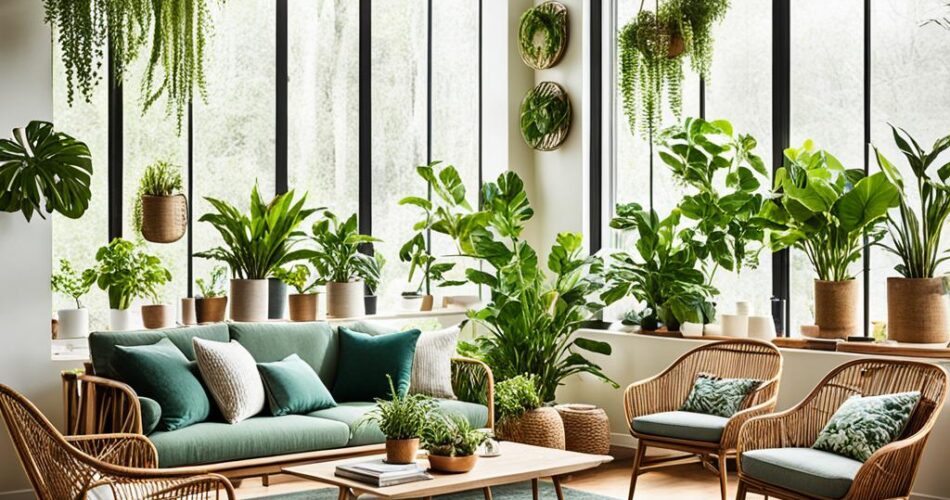Our modern lives keep us indoors. Biophilic interior design blends nature with modern looks. It fosters peace and wellness in our homes.
This design style centers around natural elements. Indoor plants, natural light, organic shapes, sustainable materials. It connects us to nature’s positive impacts.
Biophilic principles create spaces nurturing nature. Lush greenery, natural materials, maximized light, organic shapes. This nature-inspired approach enhances well-being.
Key Takeaways
- Biophilic design integrates nature into indoors.
- It uses plants, lighting, shapes, sustainable materials.
- Research shows nature’s positive health impacts.
- It creates restorative, nature-connected spaces.
- Bringing nature in offers harmony, rejuvenation.
Unveiling the Concept of Biophilic Interior Design
Biophilic design focuses on humanity’s deep bond with nature. Its aim is to promote well-being by integrating natural elements into built spaces. This concept has gained popularity as visually appealing nature-connected environments positively impact mental and physical health.
Biophilic design embraces the biophilia hypothesis, suggesting humans have an innate tendency to connect with nature. Incorporating elements like natural light, green walls, and organic patterns fosters harmony between humans and the natural world.
The term “biophilia” was coined by Erich Fromm in 1973, describing humans’ attraction to living beings. However, Edward O. Wilson popularized the concept, asserting this nature connection is rooted in our biology and evolutionary history.
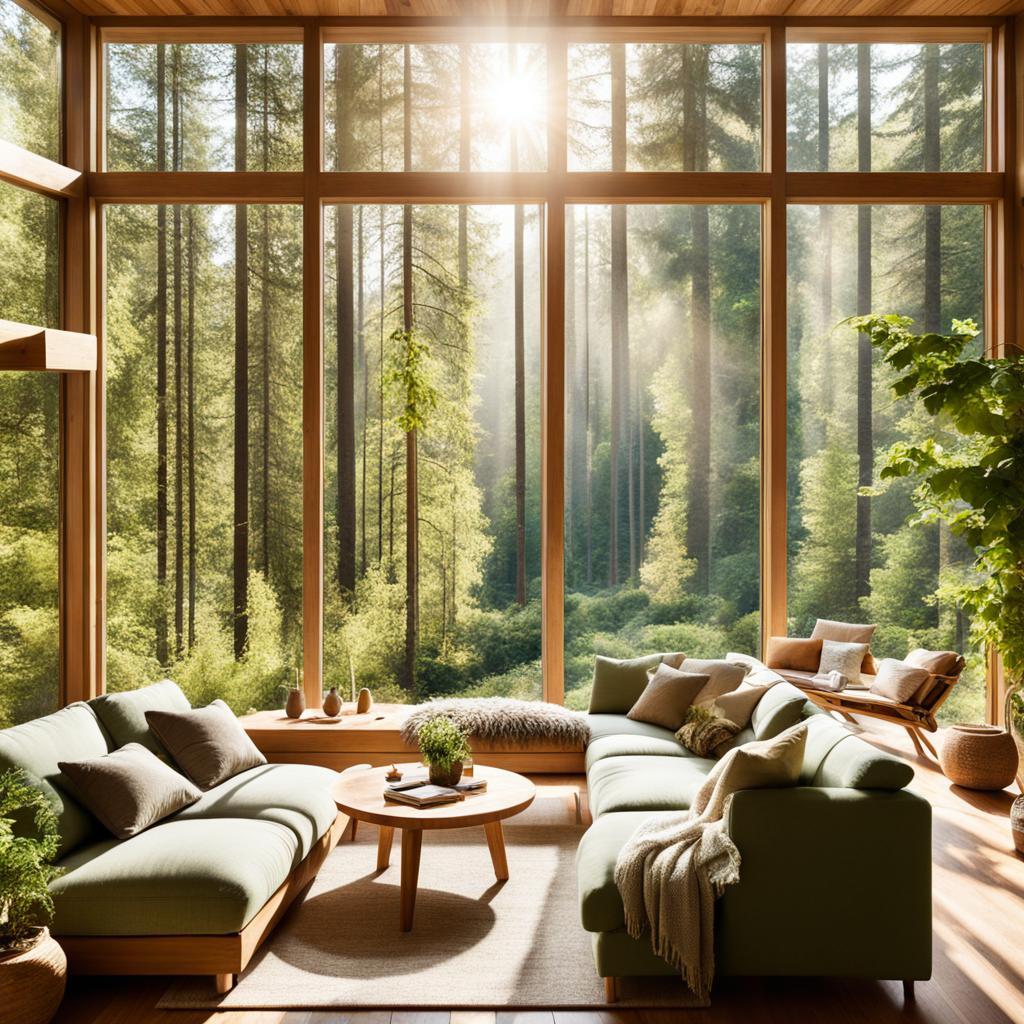
Benefits of Biophilic Design for Wellbeing
Incorporating biophilic principles like natural light, greenery, water features, and organic materials reduces stress and improves cognitive function. These wellness-focused environments create restorative spaces that facilitate mental restoration, relaxation, and reflection, aligning with human-centered design principles.
By embracing biophilic design, we create harmonious wellness spaces and nature-inspired interiors. These foster a deeper connection with the natural world, promoting happiness, well-being, and fulfillment while contributing to sustainable living.
| Biophilic Design Element | Benefit |
|---|---|
| Natural Light | Reduces stress, increases productivity |
| Indoor Plants | Purifies air, reduces pollutants, boosts oxygen |
| Nature-Inspired Patterns | Evokes calmness and tranquility |
| Natural Materials | Enhances aesthetics and tactile sensory experiences |
| Biophilic Elements | Boosts concentration, focus, and creativity |
Maximizing Natural Light and Views
In biophilic interior design, harnessing natural light and integrating nature views are crucial. These foster a harmonious connection to nature.
Daylighting strategies incorporate biophilic elements like large windows, skylights, and glass doors. This allows natural sunlight into indoor spaces.
It promotes vitamin D production, regulates circadian rhythms, and enhances overall well-being.
Importance of Daylighting in Biophilic Spaces
Exposure to natural light yields numerous scientifically-proven benefits. These include reduced stress levels, improved air quality, and boosted mood and productivity.
By incorporating biomimicry design principles, biophilic spaces leverage natural light’s restorative power. This creates environments supporting physical and mental health.
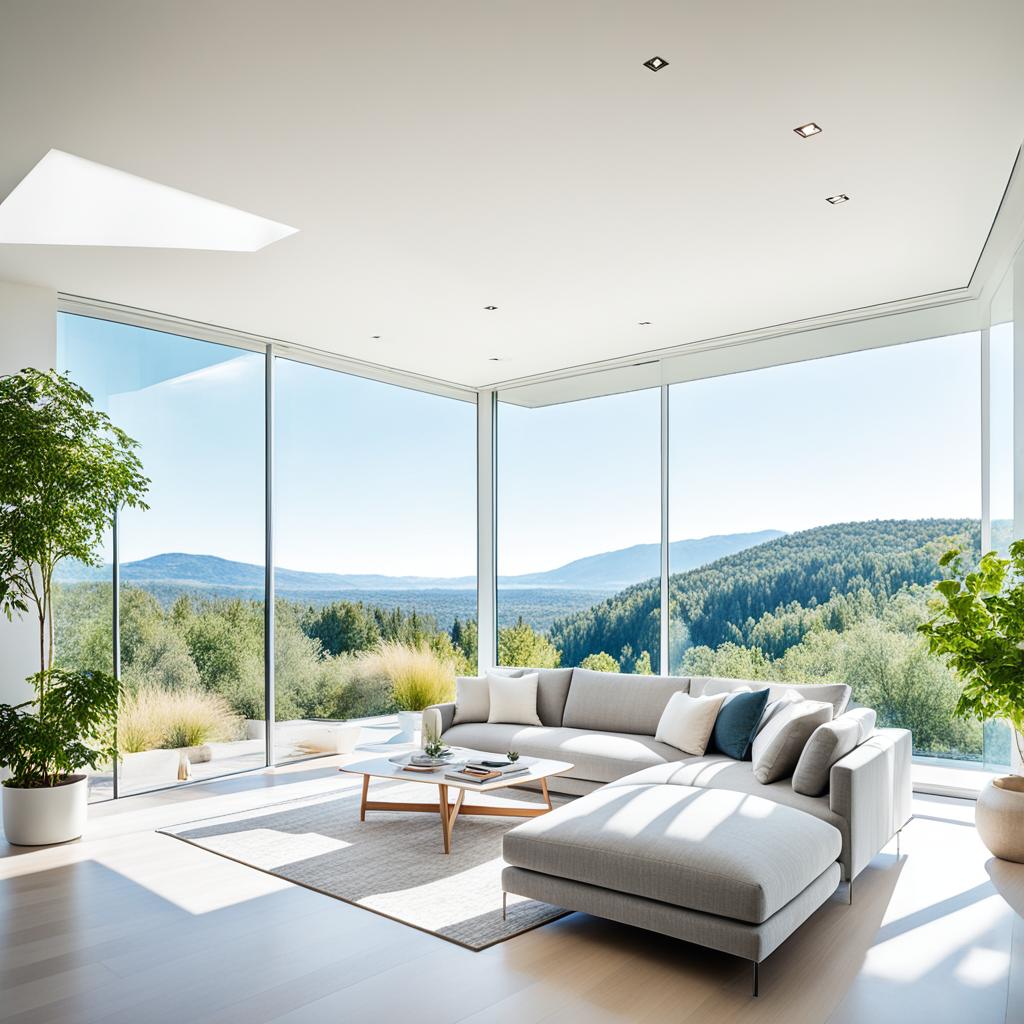
Strategically Placed Windows and Skylights
Thoughtful window, skylight, and reflective surface placement is crucial in biophilic design. It provides unobstructed outdoor views, strengthening the human-centric approach.
Studies indicate nature view exposure can lower cortisol levels, enhance cognitive function, and cultivate tranquility. This contributes to overall well-being.
Velux offers sustainable rooflight solutions through bespoke design principles like terrace windows, cabrio balcony windows, and sun tunnels mimicking natural lighting variations.
Natural light, water elements, and organic materials contribute to biophilic interior design’s aesthetic and functional benefits.
By integrating strategic daylighting and nature views, biophilic design creates restorative environments promoting well-being, productivity, and nature appreciation.
This approach aligns with eco-friendly design, sustainable living, and nature-inspired decor principles. It seamlessly blends outdoor beauty with modern indoor spaces.
Incorporating Greenery and Living Elements
Biophilic interior design embraces greenery and living elements indoors. These natural additions enhance aesthetics and offer well-being benefits.
Indoor Plants for Air Purification
Indoor plants purify air by removing toxins and increasing oxygen. Plants like succulents, ferns, and palms decorate while improving air quality. Incorporating these natural air purifiers promotes tranquility and improved concentration.
Living Walls and Vertical Gardens
Living walls and vertical gardens bring lush greenery indoors. These innovative features add visual appeal and connect us to nature. They foster serenity and well-being by integrating the natural world.

Incorporating greenery positively impacts mental and physical health. Studies suggest biophilic design reduces stress, improves cognitive function, and increases overall well-being. Integrating nature into indoor environments is essential for a balanced lifestyle.
Biophilic interior design creates visually stunning and healthier spaces. Potted plants, living walls, and vertical gardens bring the outdoors in, promoting well-being.
| Plant Type | Air Purification Ability | Light Requirements | Maintenance Level |
|---|---|---|---|
| Snake Plant | High | Low Light | Low |
| Peace Lily | High | Moderate Light | Moderate |
| English Ivy | High | Bright Light | Moderate |
| Boston Fern | Moderate | Indirect Light | High |
The table highlights popular indoor plants’ air purification, light requirements, and maintenance levels. Carefully selecting and incorporating these natural elements creates beautiful and healthy living spaces.
Utilizing Biomorphic Forms and Patterns
Incorporating nature-inspired patterns, textures, and organic forms creates visually appealing and calming environments. These elements evoke a subconscious connection to the natural world, fostering a harmonious and restorative atmosphere.
Nature-Inspired Patterns and Textures
Fractals, intricate geometric patterns found in nature, have remained timeless in interior design. They seamlessly bring nature into built environments. These patterns, inspired by ferns, trees, roots, leaves, and fungal mycelium, add depth and complexity to spaces.
Another trend incorporates desert-inspired decor, featuring warm terracotta, ochre shades, burnt oranges, umber, and brown textures. These earthy tones and rippled patterns, reminiscent of sand dunes sculpted by wind and water, create a grounding and serene ambiance.
Biomorphic forms and patterns incorporated into the built environment have been scientifically proven to help reduce stress levels by enhancing cognitive performance and shifting focus.
Organic Forms and Biomorphic Shapes
Embracing organic forms and biomorphic shapes is another hallmark of biophilic design. The “Curve Appeal” trend, with curved sofas, walls, bars, and kitchen islands, exemplifies this principle. These fluid, natural lines evoke a sense of flow and movement, creating a calming atmosphere.
Incorporating natural materials like wood elements and stone accents contributes to a multi-sensory experience. Furniture showcasing wood grain patterns in an unprocessed state, like live-edge tables and concentric tree rings, celebrates the beauty of nature in its raw form.

From sea urchin-inspired accessories to moss-covered rocks and textured rugs mimicking mossy landscapes, these nature-connected elements foster a deeper human-nature connection within indoor spaces.
| Nature-Inspired Pattern | Application in Interior Design |
|---|---|
| Fractal leaf patterns | Wall coverings, textiles, artwork |
| Golden Ratio (Fibonacci Series) | Furniture proportions, architectural features |
| Rippled desert textures | Rugs, upholstery, wall finishes |
| Biomorphic shapes | Lighting fixtures, sculptures, decor accents |
By embracing these nature-inspired patterns, textures, and organic forms, biophilic design creates spaces that connect us to the restorative power of the natural world. It promotes well-being and a deeper appreciation for the beauty that surrounds us.
Multi-Sensory Experiences
Biophilic design engages all senses, creating multi-sensory experiences. By incorporating natural fragrances, sounds, and textures, nature-centric spaces offer retreats aligned with green building principles.
Natural Fragrances and Sounds
Scent and sound powerfully impact biophilic design. Natural fragrances like essential oils promote relaxation, evoking positive emotions.
Lavender, chamomile, and sandalwood reduce anxiety. Peppermint, jasmine, and rosemary improve alertness and cognitive performance.
Water features or nature recordings create calming acoustics, serving as effective barriers. Researchers study how these sensory experiences impact stress, respiration, physical and mental health.
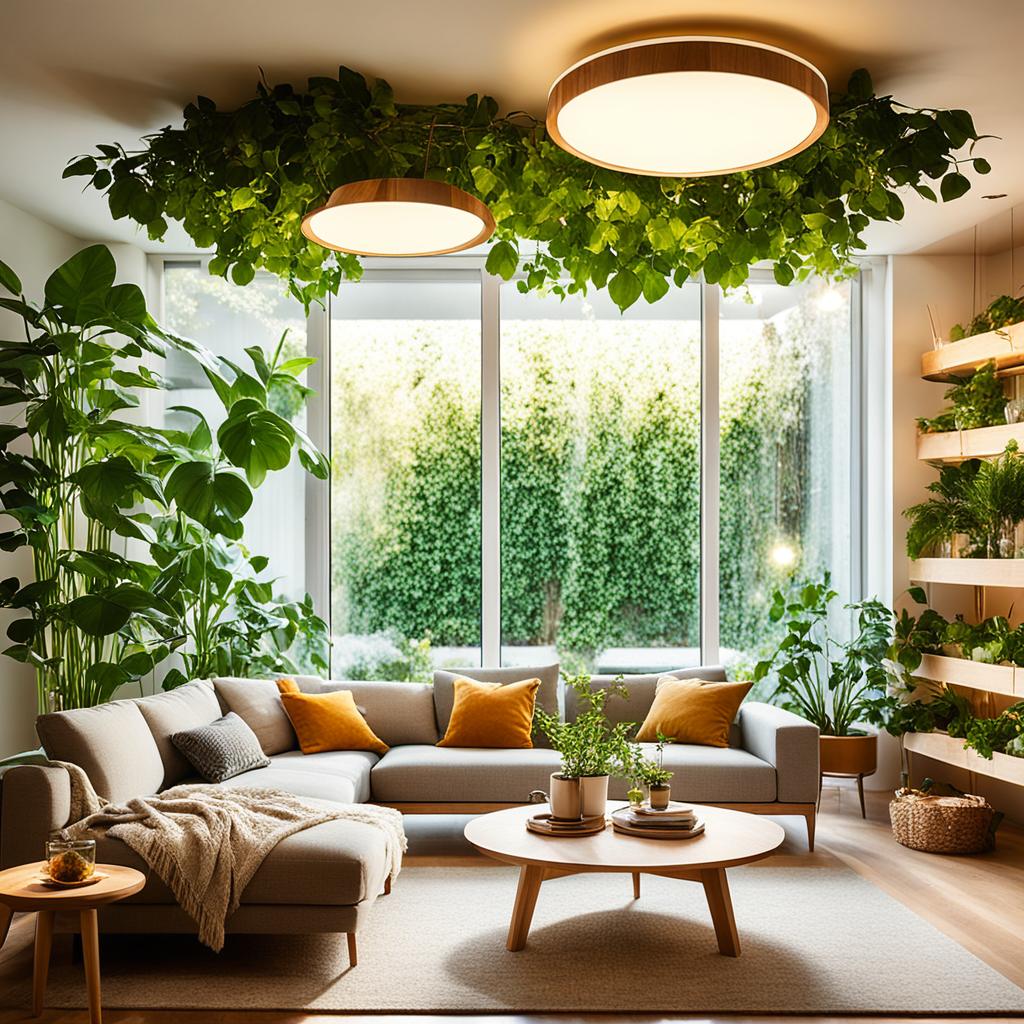
Tactile Connections with Nature
Biophilic design emphasizes tactile elements providing sensory experience through touch. Natural wood, textured stone, and water sounds create tangible outdoor connections.
Touching and hearing water reduces stress, fostering place and community. Natural materials like wood enhance indoor environment quality.
Exposure to wood paneling links to lower blood pressure. Reclaimed wood associates with feeling better, healing faster, and increased productivity.
Through natural or simulated experiences, biophilic design creates wellness-focused, rejuvenating spaces engaging senses and promoting well-being.
Utilizing Natural and Sustainable Materials
Biophilic interior design highlights eco-friendly furnishings and sustainable materials evoking nature connection. Natural elements like wood, stone, and bamboo bring earthy aesthetics and healthier indoor environments. These materials offer functional benefits like improved air quality and acoustic regulation, aligning with wellness-focused design principles.
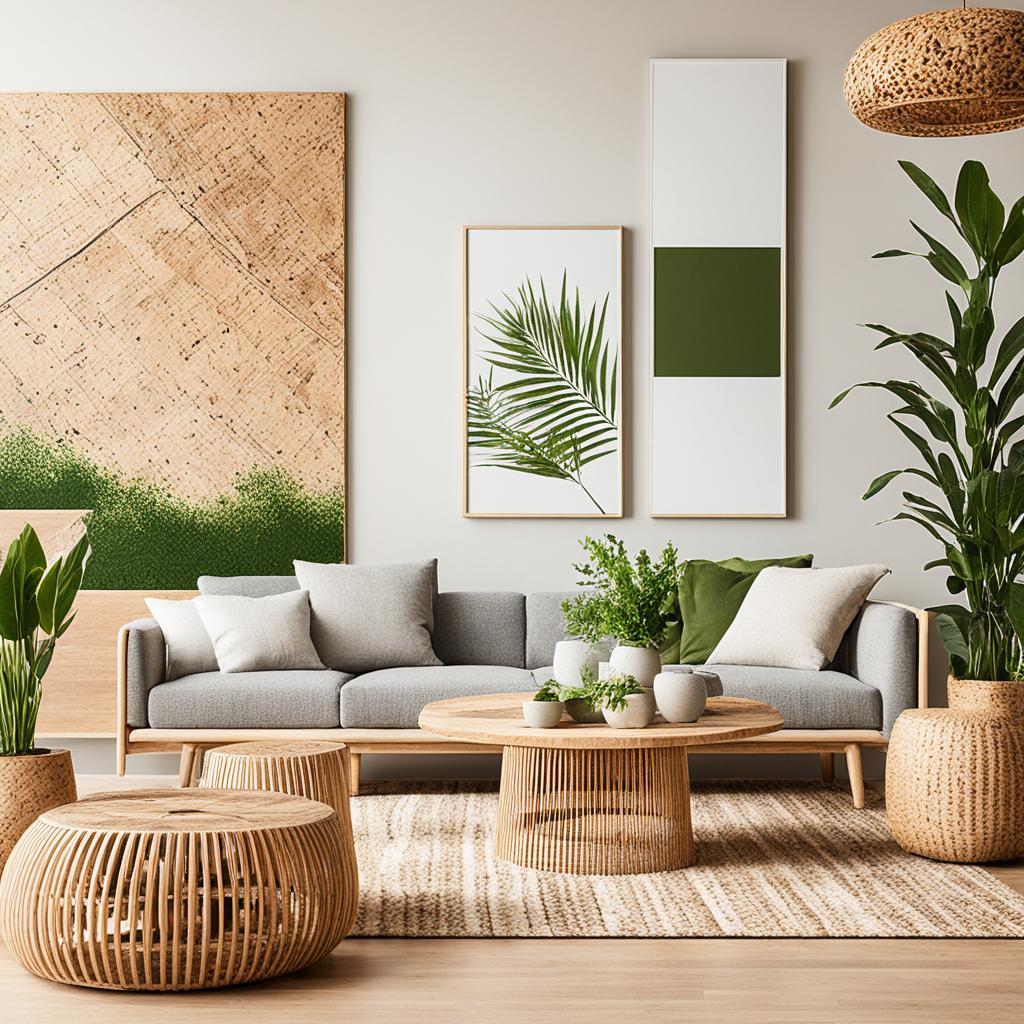
Wood, Stone, and Bamboo Elements
The warmth and texture of natural materials like wood, stone, and bamboo create harmonious living spaces. Wooden furniture, floors, and accents lend cozy, organic ambiance. Stone surfaces and features add grounding, elemental presence. Bamboo, rapidly renewable, offers versatile and sustainable flooring, furniture, and decor options.
Eco-Friendly and Renewable Resources
Incorporating eco-conscious spaces through eco-friendly and renewable resources hallmarks biophilic design. These materials reduce environmental impact and contribute to organic shapes and patterns mimicking nature. From recycled glass tiles to reclaimed wood, sustainable material options foster seamless indoor-outdoor connection.
By embracing natural and sustainable materials, biophilic design creates spaces that are not only aesthetically pleasing but also promote natural light maximization, improved indoor air quality, and a deeper connection with the natural world.
| Material | Benefits | Applications |
|---|---|---|
| Wood | Warmth, texture, acoustic regulation | Furniture, flooring, accent walls |
| Stone | Durability, natural patterns, thermal regulation | Countertops, fireplaces, backsplashes |
| Bamboo | Renewable, strong, eco-friendly | Flooring, cabinetry, decor accents |
Thoughtfully incorporating natural color palettes and organic design elements, biophilic design creates tranquil spaces contributing to sustainable living practices.
Spaces for Retreat and Connection
Biophilic design principles emphasize balanced environments that cater to our innate need for connection and solitude. These sustainable living spaces blend organic elements and natural material integration to foster a harmonious relationship between humans and nature.
At the heart of wellness-centered design lies dedicating spaces for personal retreat and rejuvenation. Indoor gardens, cozy nooks with natural materials, and serene outdoor areas provide sanctuary for quiet contemplation. These sanctuaries offer opportunities to reconnect with nature and find inner peace.
Simultaneously, biophilic design acknowledges social connection and community’s importance. Communal areas enriched with indoor greenery and natural light encourage interaction and foster belonging. These green living spaces create an inviting atmosphere for gathering, sharing experiences, and strengthening bonds.
This balance between retreat and connection achieves through thoughtful design incorporating sensory experiences rooted in nature. Soothing water features, natural fragrances, and tactile materials provide a multi-sensory experience calming the mind and rejuvenating the spirit.
The integration of indoor gardens promotes relaxation, improves air quality, and fosters a nature connection. Natural materials engage senses through textures, scents, and visual appeal, creating a calming atmosphere. Community spaces encourage interaction, shared experiences, and belonging.
Natural lighting regulates circadian rhythms, boosts mood, and promotes productivity. By striking this harmonious balance between spaces for retreat and connection, biophilic design fosters overall well-being, cultivating a serene atmosphere nurturing individual and communal needs.
| Design Element | Function | Biophilic Impact |
|---|---|---|
| Indoor Gardens | Personal Retreat | Promotes relaxation, improves air quality, and fosters a connection with nature. |
| Natural Materials | Multisensory Experience | Engages senses through textures, scents, and visual appeal, creating a calming atmosphere. |
| Community Spaces | Social Connection | Encourages interaction, shared experiences, and a sense of belonging. |
| Natural Lighting | Enhancing Well-being | Regulates circadian rhythms, boosts mood, and promotes productivity. |
Biophilic Design in Different Settings
The transformative power of biophilic design transcends boundaries. It seamlessly integrates natural elements into diverse environments. This holistic approach nurtures our innate nature connection. It fosters well-being and productivity.
Residential Spaces
Within our homes, biophilic principles create tranquility oases. Incorporating sustainable wooden furniture adds warmth and character. It establishes an eco-friendly interior design.
Botanical prints and earthy color palettes infuse living spaces with serenity. They invite nature’s embrace indoors. Strategically placed windows facilitate an outdoor-indoor connection. Daylight integration permeates the environment.
Embracing organic principles, homeowners craft mind, body, and soul nurturing havens. Curved lines and natural elements evoke coziness. Indoor plants improve air quality and ambiance.
Workplaces and Offices
Biophilic design enhances workplace productivity and creativity. Introducing indoor greenery, natural materials, and daylight integration rejuvenates. These spaces foster focus and inspiration.
Living walls and vertical gardens add visual appeal. They purify air, contributing to a healthier and eco-friendlier design.
Studies show exposure to natural elements improves cognitive function. It reduces workplace stress levels and job satisfaction. Embracing biophilic principles creates nurturing employee environments. These foster well-being, productivity, and creativity.
Sustainability and Biophilic Design
Biophilic design seamlessly aligns with sustainability goals. It emphasizes using eco-friendly interior solutions. This approach promotes a deeper connection with nature.
By creating healthy living environments, biophilic design integrates nature-inspired patterns and elements. This holistic approach benefits individuals. It also contributes to nature-integrated buildings and environmentally responsible design.
Reducing Environmental Impact
Biophilic design reduces energy consumption through natural light integration. By maximizing natural daylighting through thoughtful window and skylight placement, biophilic spaces significantly decrease reliance on artificial lighting.
This lowers energy demands and associated greenhouse gas emissions. The use of sustainable and renewable materials like bamboo and reclaimed wood minimizes depletion of non-renewable resources, further reducing environmental impact.
Fostering Eco-Conscious Lifestyles
Biophilic design fosters a deeper appreciation for the natural world. It encourages eco-conscious interiors and lifestyles through integrating nature-inspired elements like indoor plants and living walls.
This connection inspires individuals to adopt sustainable practices like reducing waste, conserving water, and supporting eco-friendly initiatives. Biophilic design principles align with ancient philosophies like feng shui, emphasizing harmonious human-nature integration.
By creating wellness-focused spaces promoting physical and mental well-being, biophilic design encourages a holistic approach to sustainable living. Personal health and environmental stewardship are intertwined in this approach.
Designing for Human-Nature Connection
Biophilic design aims to strengthen the human-nature connection. It brings natural elements indoors, creating restorative environments. Incorporating organic materials, natural patterns, and living elements enhances mental health. It reduces stress levels and boosts productivity. These human-centric environments align with sustainable design concepts, promoting well-being.
Enhancing Mental Health and Productivity
Natural materials indoors profoundly impact psychological well-being. Wood panels can decrease feelings of depression. Steel panels may amplify negative emotions. Incorporating live plants immediately improves air quality by releasing oxygen and removing pollutants, creating a healthier environment.
Companies prioritize employee wellness, incorporating biophilic elements. This enhances moods, morale, and productivity. Biophilic design presence in commercial sectors attracts and retains talent through nature-inspired workplaces.
Creating Restorative Environments
Biophilic design is embraced by education and healthcare sectors due to positive impacts on learning and healing. The hospitality market incorporates biophilic elements, fostering tranquility and rejuvenation.
The wellness trend leads to biophilic design growth in various building types. A seminal paper reviewed over 500 publications on biophilic responses, uncovering useful patterns.
The paper presents 14 biophilic design patterns adaptable for project implementation. It focuses on nature patterns mitigating stressors or enhancing qualities across sectors and built environments.
Conclusion
Urban living often disconnects us from nature. Biophilic interior design blends nature’s beauty with modern spaces. It fosters connection between humans and nature, promoting well-being.
Biophilic interior design embraces green architecture principles. It emphasizes eco-friendly practices and environmental reverence. Living walls, indoor plants, and renewable resources enhance aesthetics.
Biophilic design patterns and biomimicry principles boost cognitive function. Nature-inspired designs evoke tranquility and emotional well-being. They’re ideal for residential, commercial, and eco-friendly interiors.
